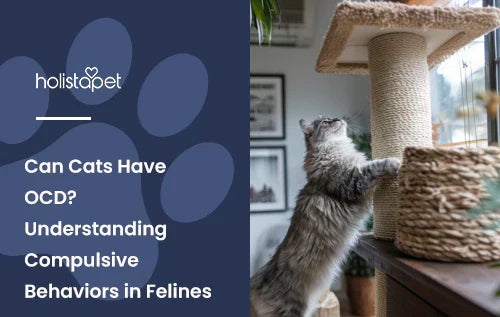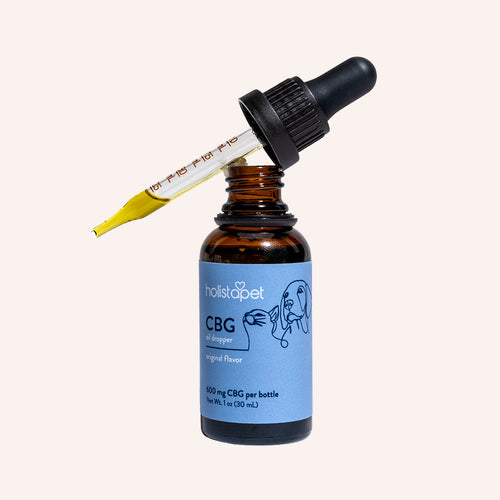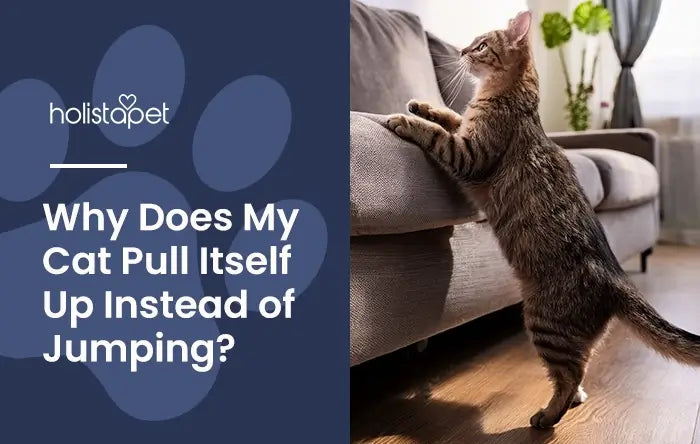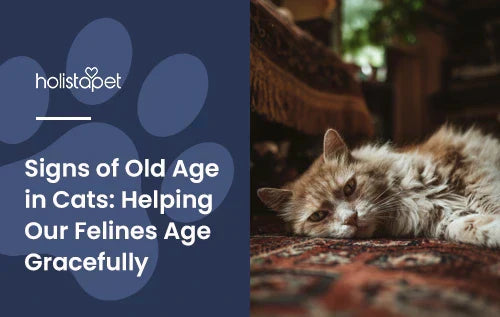Can cats have OCD? Well, they can show behaviors that look just like it! Some cats lick the same spot for hours, chase their tails, or fixate on random objects like it's their new hobby. These actions might look funny at first, but they often point to something deeper.
Feline OCD appears when repetitive behaviors replace normal routines. Many kitties develop these habits because of worry, boredom, or changes in their environment. Watching for these patterns helps catch early signs before they lead to soreness or emotional stress.
What Does "OCD" Mean in Cats?

When people ask what OCD means in cats, it usually refers to feline obsessive-compulsive disorder. That's a pattern of repetitive behaviors that serve no clear purpose. Affected felines might lick, chew, or chase things even when nothing's wrong. These habits often look odd but are typically linked to high arousal or anxious behaviors.
Unlike humans, cats don't obsess over thoughts. Their focus stays on actions. Many cats repeat certain motions because it gives them a sense of control or comfort. When such actions become exaggerated or nonstop, they move beyond normal grooming or play. They then start affecting behavior and overall well-being.
Why Cats Can't Be Officially Diagnosed With OCD
Cats can't be officially diagnosed with OCD. That's because the condition, as defined in humans, depends on self-reported thoughts and feelings. Cats can't tell us what's running through their minds, can they?
In veterinary medicine, "feline obsessive-compulsive disorder" describes compulsive behaviors that mimic human OCD. It's not an official medical diagnosis, though.
Instead, vets rely on behavioral clues. They watch for repetitive actions that don't serve an obvious purpose, like over-grooming or tail-chasing. These signs suggest anxiety-related or compulsive disorders, though each case varies. The goal is understanding what drives such behaviors rather than labeling them with a human term.
How Feline Obsessive-Compulsive Behavior Differs From Human OCD
Feline obsessive-compulsive behavior looks different from the human version. People experience intrusive thoughts that drive repetitive actions. Cats, on the other hand, act without that mental backstory. Their repetitive actions usually come from anxious behaviors. Changes in the environment or genetic predisposition can also play a role.
Many felines develop habits like excessive grooming, tail-chasing, or fixation on objects. These actions help them cope with worry or boredom. Unlike humans, cats can't reason through their feelings or stop the urge once it starts. What looks like stubbornness is really instinct mixed with emotional stress. It's their unique way of trying to regain calm in a noisy world.
Common Signs of OCD-Like Behavior in Cats
Cats can show a wide mix of obsessive-compulsive behaviors. These actions often start small. They then become daily habits that take over normal behaviors. Knowing what to look for helps pet parents better support their cat's well-being. Keep an eye out for:
- Excessive Grooming or Hair Loss. Some cats lick one area until they create bald patches. This repetitive grooming often signals nervous energy or frustration.
- Tail-Chasing, Pacing, or Fixation on Objects. Repetitive movements, such as chasing tails or pacing the same path, can reveal anxiety-related tension or boredom.
- Repetitive Meowing or Constant Attention-Seeking. Vocal cats may call nonstop, especially when they feel lonely or overly attached.
- Obsession With Routines or Certain Spots. Many cats insist on strict routines or claim the same nap zone. Any change sparks agitation or exaggerated behaviors.
What Causes Repetitive or Compulsive Behavior in Cats?
Compulsive disorders in felines often start with small triggers that grow over time. Some causes are easy to spot, while others hide beneath the surface. Understanding the underlying motivation behind these behaviors helps find the right fix. Consider the following:
- Stress and Anxiety. Upset or nervous cats may lick, pace, or chase their tails when feeling uneasy or threatened.
- Boredom or Lack of Enrichment. Cats need stimulation. Without toys or playtime, they invent repetitive behaviors to stay busy.
- Past Trauma or Environmental Changes. A move, new pet, or loud noise can spark anxious behaviors that turn into habits.
- Underlying Medical Issues to Rule Out. Sometimes, swelling, soreness, or skin irritation can trigger excessive licking or paw shaking, so a vet check is important.
How Vets Diagnose Feline Compulsive Behavior
Vets start by ruling out underlying medical conditions that could cause similar actions. Diagnostic tests may include bloodwork, skin checks, or thyroid screenings. These can help identify soreness, allergies, or other medical causes. Once those diagnostic criteria get cleared, attention shifts to possible behavior problems.
A detailed history helps spot patterns. The vet may ask when the repetitive behaviors began, how often they happen, and what triggers them.
Observing a cat's environment also matters, from loud noises to changes in routine. In severe cases, a veterinary behaviorist may step in and help. They can create a treatment plan that includes behavior modification and calming support.
How To Help a Cat With OCD-Like Behaviors
Helping a cat with obsessive-compulsive behaviors takes patience and a calm approach. The goal is to reduce anxious behaviors, replace repetitive habits with healthier ones, and make your kitty feel secure in their space. Try the following:
- Create a Calm, Predictable Environment. Keep feeding times, play sessions, and quiet hours consistent. Cats thrive on routine and predictability.
- Offer Mental and Physical Stimulation. Interactive play, food puzzles, and chew toys help redirect restless energy into positive outlets.
- Use Gentle Behavior Training Techniques. Reward calm actions with a food treat or affection to encourage alternative behaviors.
- Introduce Calming Aids and Supplements. Natural calming supplements or CBD (cannabidiol) products can promote relaxation alongside veterinary guidance.
Natural Calming Support From HolistaPet: Cat CBD You Can Trust

HolistaPet offers a trusted line of CBD products for cats designed to promote calmness and emotional balance. Each wellness option, from treats and chews to soothing oils, helps feline pets who deal with anxious behaviors or repetitive habits. When paired with behavior training and veterinary guidance, CBD can make a real difference in easing stress and supporting relaxation.
CBD works by interacting with a cat's endocannabinoid system. That's the network that helps manage mood, sleep, and response to tension. By supporting this system, CBD helps promote calm, steady behavior without any "high."
HolistaPet's CBD comes from American-grown hemp that meets Farm Bill standards. Each product is third-party lab-tested, broad-spectrum, and free of fillers or preservatives. It's a plant-based, cruelty-free option pet parents can trust. Shop HolistaPet's Cat CBD Collection here.
When To Seek Professional Help
Sometimes, feline OCD grows beyond what home adjustments can fix. If your cat's repetitive behaviors cause hair loss, skin irritation, or self-directed aggression, it's time to call the vet. They'll check for underlying medical problems and help rule out conditions like swelling, soreness, or thyroid imbalance.
A veterinary behaviorist can also help and design a personalized plan. It can include behavior training, environmental changes, and, in some cases, calming supplements.
Getting help early prevents physical harm and emotional distress. Most felines improve once the exact cause is well understood and their environment supports calmer, more natural behaviors.
FAQs - Cats and OCD
Curious about obsessive-compulsive behaviors in cats? You're not the only one wondering how these quirky habits start or what they mean. Here's what other cat parents ask when their pets start licking, pacing, or meowing nonstop.
Is there such a thing as feline obsessive-compulsive disorder?
Yes, there is something called feline obsessive-compulsive disorder, or feline OCD. It involves repetitive behaviors like over-grooming, tail-chasing, or fabric eating that serve no obvious purpose. These behaviors usually start as responses to stress, boredom, or environmental change. Over time, they can become habits even without the original trigger. Recognizing these signs early helps protect your cat from soreness or, worse, self-mutilation.
How do I know if my cat's behavior is normal or compulsive?
Normal behaviors have clear objectives, like grooming after eating or chasing toys. Compulsive behaviors, on the other hand, happen repeatedly without apparent reasons. If your cat licks one spot nonstop or paces the same route every night, it might be a sign of feline OCD. These patterns often suggest anxious behaviors or an underlying medical problem. A vet can run diagnostic tests to find the cause and recommend the proper medical treatment.
Will my cat grow out of OCD-like behaviors?
Most cats don't simply grow out of obsessive-compulsive behaviors. These habits tend to stick around or even intensify if the underlying cause isn't addressed. Early support, like creating structure and reducing triggers, can help ease the cycle. Many cats improve with consistent behavior modification and calming support. With patience and the right plan, these behaviors can lessen over time.
Can CBD help calm my cat's obsessive habits?
Yes, CBD may help ease tension and promote a calmer state in cats with repetitive or anxious behaviors. It works with the body's endocannabinoid system, which helps manage stress and emotional balance. When combined with training and environmental adjustments, CBD can support steadier moods.
HolistaPet's CBD treats, oils, and chews are reliable options made from American-grown hemp. They're tested for purity and crafted to promote relaxation without any mind-altering effects.
Should I punish my cat for repetitive behavior?
Punishment can make things worse by increasing worry or confusion. Cats don't connect discipline with their actions the way humans do. Instead, they react with more anxious behaviors or fear.
Focus on redirection instead. Offer chew toys, playtime, or a food treat to distract them from the unwanted habit. Gentle guidance and consistency always work better than scolding or force.
Final Thoughts: Helping Your Cat Live Calmly and Confidently
Feline obsessive-compulsive disorder doesn't define your cat. It's just one piece of their unique personality puzzle. With a steady routine, playtime, and patience, most cats can manage their repetitive behaviors and return to their playful selves. Support, not punishment, builds trust and helps anxious cats feel safe.
Adding natural calming aids can make the process smoother. HolistaPet's CBD treats, chews, and oils work alongside behavior modification techniques to support emotional balance and ease tension. A relaxed kitty is a happy kitty—and that's what every pet parent wants most.


 CBD Oil for Cats - Fast Acting
CBD Oil for Cats - Fast Acting
 CBD Cat Treats - Easy Dose
CBD Cat Treats - Easy Dose
 CBD Calming Chews for Cats - Highly Rated
CBD Calming Chews for Cats - Highly Rated
 CBG Oil for Dogs and Cats - Loved by Thousands
CBG Oil for Dogs and Cats - Loved by Thousands





Leave a comment
All comments are moderated before being published.
This site is protected by hCaptcha and the hCaptcha Privacy Policy and Terms of Service apply.